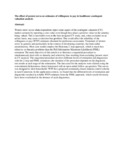| dc.contributor.author | Fonta, William | |
| dc.contributor.author | Ichoku, H. | |
| dc.contributor.author | Kabubo-Mariara, Jane | |
| dc.date.accessioned | 2013-05-20T07:51:47Z | |
| dc.date.available | 2013-05-20T07:51:47Z | |
| dc.date.issued | 2010 | |
| dc.identifier.citation | Applied Health Economics and Health Policy | en |
| dc.identifier.uri | http://econpapers.repec.org/scripts/search/search.asp?ft=university+of+Nairobi | |
| dc.identifier.uri | http://erepository.uonbi.ac.ke:8080/xmlui/handle/123456789/23844 | |
| dc.description.abstract | 'Protest zeros' occur when respondents reject some aspect of the contingent valuation (CV) market scenario by reporting a zero value even though they place a positive value on the amenity being valued. This is inevitable even in the best-designed CV study, and, when excluded on an ad hoc basis, may cause a selection bias problem. This could affect the reliability of the willingness to pay (WTP) estimates obtained for preference assessment. Treatment of 'protest zeros' in general, and particularly in the context of developing countries, has been rather unsatisfactory. Most case studies employ the Heckman 2-step approach, which is much less robust to co-linearity problems than the Full Information Maximum Likelihood (FIML) estimator. The main objective of this article is to illustrate a sequential procedure to simultaneously deal with co-linearity and selectivity bias resulting from excluding 'protest zeros' in CV analysis. The sequential procedure involves different levels of estimation and diagnostics with the 2-step and FIML estimators; the duration of the procedure depends on the diagnostic test results at each stage of the estimations. The data used for the analysis were elicited using the conventional dichotomous choice buttressed with an open-ended follow-up question. The survey was designed to elicit households' WTP for a proposed community-based malaria control scheme in rural Cameroon. In the application context, we found that the different levels of estimation and diagnostics resulted in reliable WTP estimates from the FIML approach, which would obviously have been overlooked in the absence of such diagnostics. | en |
| dc.language.iso | en | en |
| dc.relation.ispartofseries | Vol. 8, issue 4, pages 225-237 (2010); | |
| dc.subject | Contingent-valuation | en |
| dc.subject | Malaria | en |
| dc.subject | prevention | en |
| dc.subject | Willingness-to-pay | en |
| dc.title | The effect of protest zeros on estimates of willingness to pay in healthcare contingent valuation analysis | en |
| dc.type | Article | en |
| local.publisher | School of Economics, University of Nairobi, Nairobi, Kenya | en |

